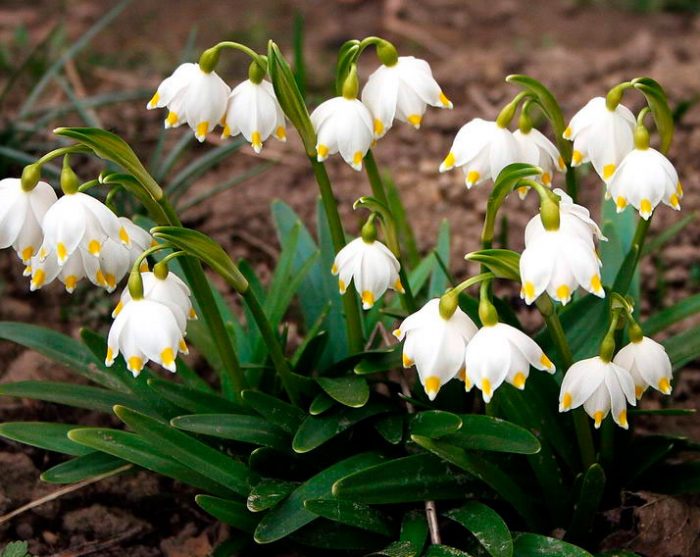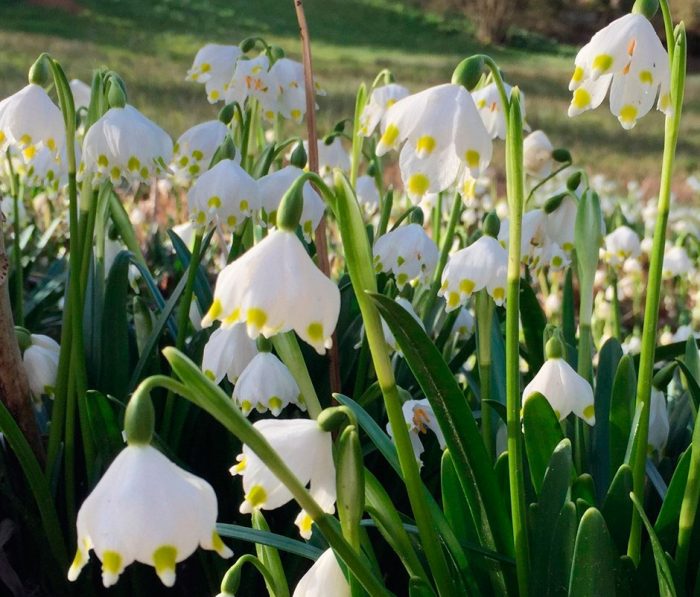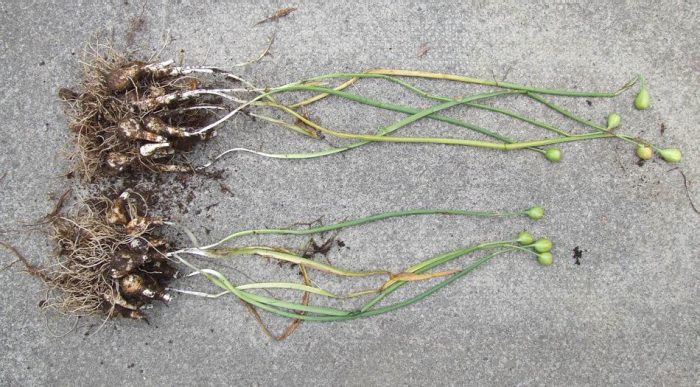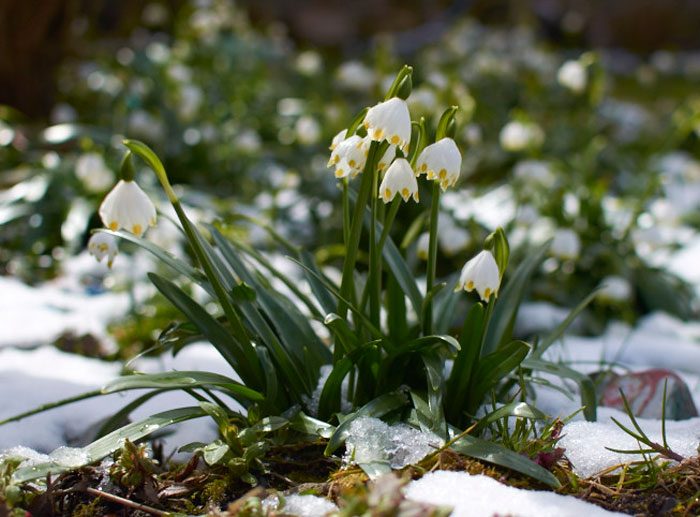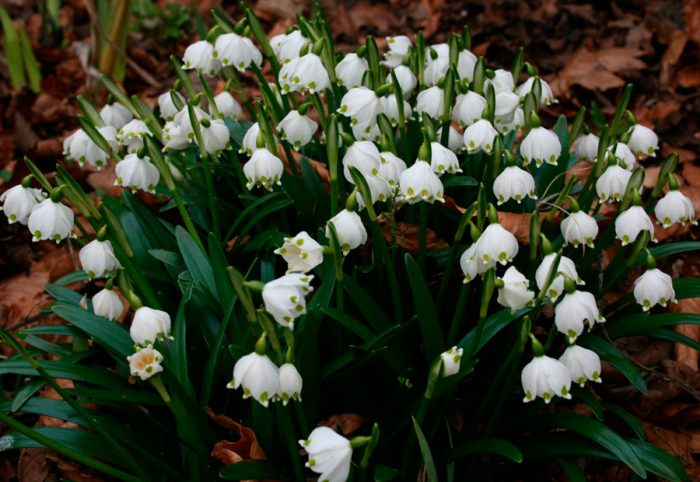White flower (Leucojum) is a member of the Amaryllis family. This genus includes about 10 species. In nature, such plants are found in Turkey, Central Europe, the Mediterranean, Iran and North Africa. The name of this genus in translation from Greek means "white violet". There is a legend related to the origin of this flower. Once God fell in love with a village shepherdess, but she more than once rejected his advances. However, he planned to lure her into the cloud by trick and achieve reciprocity in any way. God believed that the beloved, seeing the whole world at her feet, would certainly want to live with him. At night, he stole and hid a cow that belonged to this girl. Appearing to her in the morning, he offered his help. God lifted his beloved to a cloud, since she could quickly find her cow from there. The girl was amazed at the beauty that opened up to her eyes. She, imagining herself a goddess, took the boxes, which God needed to control the weather, and began to shake out what was in them to the ground. So, fog fell from the first box, and a summer shower from the next. In the third there was snow and, laughing, the girl shook it to the ground. The time of winter has already passed, and therefore God was angry with the girl! God made it so that when it touched the ground, the snow turned into white flowers - beautiful white flowers. And God sent the frivolous girl back, where she continued to graze the cows. Since then, at the end of May, the snow-white flowers of the white flower are revealed. Gardeners cultivate only 2 species of this plant.
Content
Features of the white flower
The white flower has bulbs, consisting of membranous closed white scales, as well as perennial thick roots. The roots eventually die off along with the part of the bottom from which they sprouted. Linear and belt-shaped sheet plates. In spring species, their formation occurs at the same time with flowers, while in autumn ones, they grow after the plant has bloomed. Annually, the white flower forms 2 or 3 lower scales, behind which 2 or 3 leaf plates with a closed base and one with an open base are laid.It is from the sinus of such a leaf plate that the flower arrow develops, while the formation of a renewal bud is observed at its base. The erect, slightly flattened peduncle can be rounded or double-edged; during the ripening of the fruit, it droops. The arrow ends with a membranous wing of green color; drooping pink or white flowers on pedicels grow from its sinus. Flowers can be solitary or part of umbellate inflorescences. The broadly bell-shaped perianths include 6 leaves, at the top of which there is a spot of green or yellow color. The fruit is a fleshy box, inside of which are black seeds of an oblong or rounded shape.
Planting a white flower in the open field
What time to plant
Experts advise planting the white flower bulbs during their dormant period, and this time falls on July – September. If the weather is warm for a long time in autumn, then planting of this plant in open soil can be carried out until the first days of November. Planting material should be purchased with great care. The bulbs must be heavy and dense, and covered with intact membranes. They should also have short roots, and there should be no shoots. A bulb with overgrown long roots or with grown shoots should be planted in open soil as soon as possible. It is also recommended that the purchased bulbs are completely intact, without mechanical damage. Especially they should be absent on the bottom, and also inspect the planting material for mold. Do not buy broken, crumpled onions, as well as those with a peeled off protective shell or injured bottom. In the event that the purchased bulbs are still too early to be planted in open soil, then for storage they should be placed in a perforated plastic bag, into which shavings or sawdust should be added.
Landing features
For planting, it is recommended to choose a shaded area that is located near shrubs and bodies of water. The soil should be moist and well-drained, as well as saturated with humus. Before proceeding with planting, it is necessary to dig up the soil on the site, while introducing coarse-grained river sand or gravel into it. If the soil is poor, then leafy soil, sand and rotted manure are also introduced into it (it should not be fresh). Since this flower crop is not recommended to be grown on acidic soil, it is therefore also recommended to add a small amount of lime and rotted peat to it. Planting this plant should be done in the same way as other bulbous crops. Remember that after planting, the layer of soil above the bulb should be twice the diameter of the bulb. However, it should be noted that the thickness of this layer should not be thinner than 50 mm. If the bulb is planted too deeply, then gradually it becomes more and more. And if the planting is not deep enough, the bulbs are shrinking, however, an intensive build-up of children occurs. The planted bulbs need good watering.
White flower care in the garden
You should take care of the white flower plant in the same way as for the following garden crops: hyacinth, muscari or woodlands. This plant must be watered, weeded, loosened, and fed in a timely manner.
How to water and feed
In the first spring weeks, watering the white flower is not needed. The fact is that after the disappearance of the snow cover, moisture remains in the ground for a long time. If in the winter there was very little snow, and the spring was dry and warm, then such flowers will need to be watered regularly, while the water should be settled, and it should not be cold, while try to exclude drops from falling on the flowers.In the absence of watering, the plant will not die, but it will become stunted.
The white flower is fed with a liquid mineral complex, which should contain a small amount of nitrogen. The fact is that nitrogen helps to stimulate the intensive growth of leaf plates, but this has a negative effect on flowering. Lush greenery in wet rainy weather can cause fungal diseases in the bush. Phosphorus helps to stimulate lush flowering, and thanks to potassium healthy bulbs are formed that can winter well.
Transplantation and reproduction of a white flower
It is necessary to transplant or propagate this flower by dividing the nests only when it is dormant, namely, from June to September or October. It is recommended to transplant the bushes once every 5–7 years, otherwise the bulbs that have grown will not have enough nutrients, and the white flower will start to decay.
The dug nests should be divided. The bulbs for drying are laid in a shaded place, then they are cleaned of old, as well as diseased roots, rotten and injured scales. All mechanical damage should be sprinkled with ash or coal powder, the bulbs affected by the disease and unsuitable for planting should be thrown away. Then the children are seated in a pre-prepared area, the landing scheme is described in detail above.
Also, the reproduction of the white flower is carried out by the seed method. Freshly harvested seeds must be sown immediately after harvest or with the onset of autumn. The fact is that they, like the corydalis seeds, remain viable for a short time. During the winter period, the seeds can undergo natural stratification, which has a good effect on the further growth and development of seedlings. Seeds are sown in boxes, while the surface of the soil mixture must be covered with a special film that protects against the growth of weeds. Further, you need to observe only so that the soil mixture does not dry out. Plants grown from seeds will begin to bloom only at 7 or 8 years. Reproduction of such a culture can also occur by self-sowing, while the gardener is quite capable of controlling this process. For this, seedlings that have appeared in unnecessary places must be pulled out, and those that grow in the area designated for this need good care.
Wintering
White flower is highly resistant to frost, therefore, it is not necessary to cover it for the winter. In the event that forecasters predict a very cold and little snow winter, it is recommended to cover the area with a white flower with spruce branches.
Pests and diseases of the white flower
The white flower is resistant to diseases and pests, but still sometimes problems can begin. At the same time, the diseases in this culture are practically the same as in the snowdrop, which is also a primrose.
So, the plant can be harmed by bulbous nematodes, slugs, scoops, as well as their caterpillars. Rodents such as mice and moles can also cause harm. In autumn, you can collect the thick moth caterpillars by hand; at this time, they are preparing for pupation. If desired, you can use an insecticidal preparation to destroy them.
The nematode is a very small worm, due to which light yellow tumors form on the leaf plates. In the event that there are nematodes on the bush, then it should be dug up and burned. The remaining healthy plants must be transplanted, while before planting, the bulbs must be immersed in very warm water (from 40 to 45 degrees) for several hours. To plant them, you should choose a site located in a different location. Planting bulbous crops in areas affected by nematodes should not be carried out for 4 or 5 years.
Underground slugs prefer to live in fertile soil or in heavy clay soil.During planting, the bulb in the hole must be surrounded by a layer of coarse sand, this will get rid of this pest.
With rodents, things are more complicated, they can not only injure the bulbs with their teeth, but also drag them into their burrows. Rot can develop on gnawed bulbs, but you can only understand that the plant is sick by its stunted appearance. Such bushes should be dug out, all rotten areas are cut out from the bulbs, after which the wounds are treated with wood ash and left for several hours in the fresh air to dry. After that, the bulbs can be planted again in the soil. Mice prefer to settle in clumps of perennials or in sods with grass, so they should be at least 300 cm from the plantings of the white flower (as a rule, mice do not move further from their homes). It is also recommended to place poison baits on the site.
The greatest danger of all diseases for this culture is viral, since today it cannot be treated. When greenish or yellowish marks and many tubercles form on the foliage, as well as twisting of the leaf plate, the bush is immediately dug up and destroyed in order to avoid spreading the infection to other plants.
When a plant is infected with a fungal disease such as rust or gray mold, black or brown marks appear on the leaf plates, and a gray fluffy bloom forms on the shoot at the very surface of the soil, which will eventually spread up the stem. Cut and destroy all affected areas of the plant, then the bush and the surface of the soil under it are sprayed with a solution of the fungicidal preparation.
Types and varieties of white flower with photos and names
It was already mentioned above that gardeners grow only 2 types of white flowers.
Spring white flower (Leucojum vernum)
This species prefers to grow on the edges of beech forests, which are located in Central Europe, which also includes the Carpathians. The height of such a perennial plant is about 0.2 m. The egg-shaped bulb reaches 20 mm in diameter. Broad lanceolate leaf plates reach 0.25 m in length and 12 mm in width. The height of the peduncles is approximately 0.3 m. The drooping white flowers can be single or paired, they have a pleasant smell, and there are specks of green or yellow color at the tips of the petals. This plant blooms in April, and the duration of its flowering is 20-30 days. The fruit is a fleshy three-nested box of spherical shape. It has been cultivated since 1420. The best variety is Carpathicum: flowers are larger than the main species, and their petals are yellow specks.
Summer white flower (Leucojum aestivum)
In nature, this species can be found in the Crimea, Asia Minor and Western Asia, Southern and Western Europe and Western Transcaucasia, while it prefers to grow on river banks and floodplains. The height of such a perennial plant is about 0.4 m, the length of the leaf plates is 0.3 m, and the height of the peduncles is 0.4 m. Flowering begins from mid to late May. The drooping umbellate inflorescences consist of 3-10 white flowers. The plant blooms for about 20 days. It has been cultivated since 1588. The Gravy Giant variety is the most popular: this garden variation was obtained by English breeders, the height of the peduncles is about 0.6 m, they bear six white flowers, on the petals of which there are green-straw spots.
The Mediterranean species of the white flower, such as the hairy, long-leaved and Tingitanian, are quite spectacular, however, scientists have isolated them into a separate genus, which is called acises. Of the species that bloom in autumn in Western Europe, the autumn and pink white flowers are most often cultivated.The height of the autumn white flower is about 12 centimeters, flowering is observed in September, there are specks of green color on the petals of white flowers. At the moment, these species are also called acises and are separated into a separate genus.

